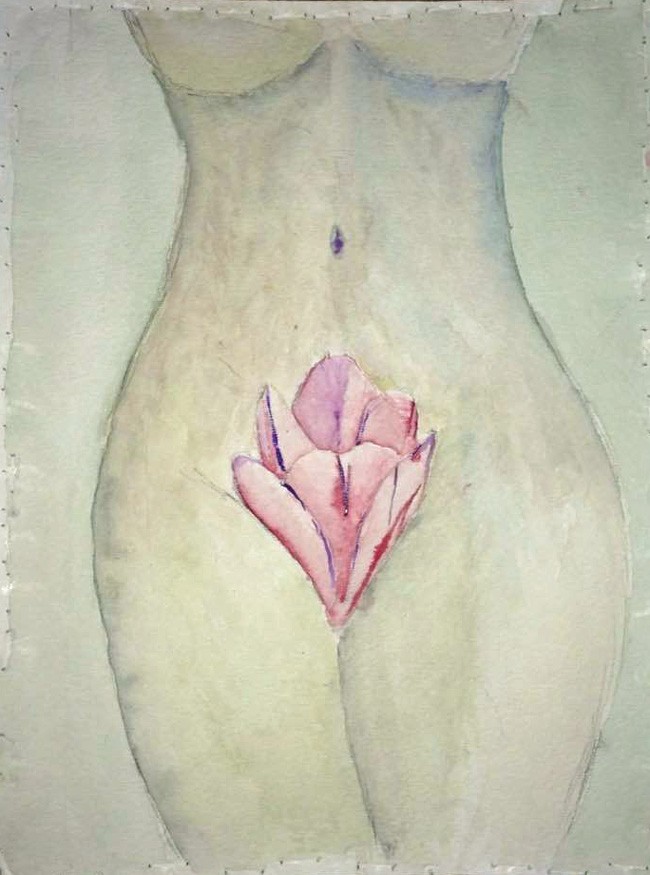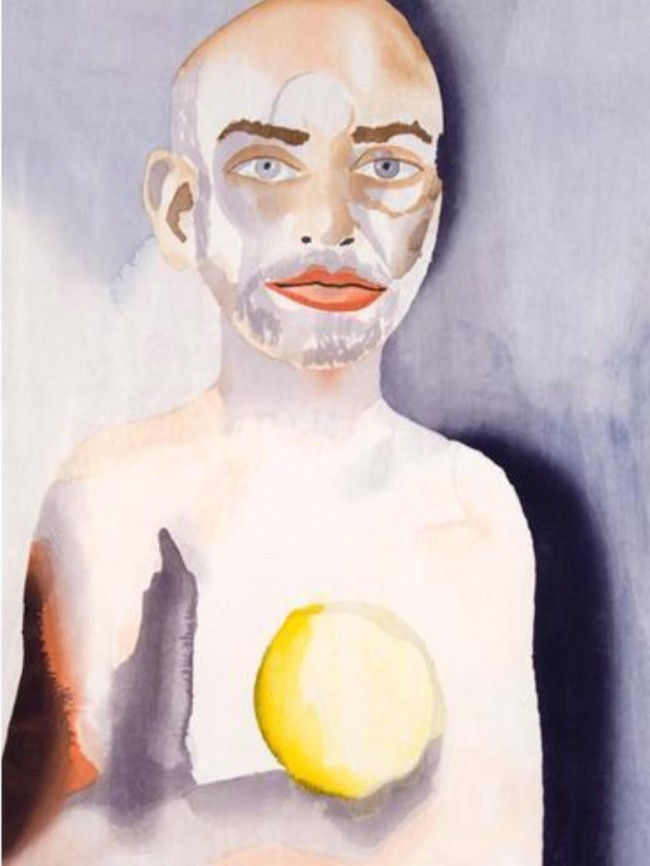
Patrick Conklin is a 17-year-old senior at Flagler Palm Coast High School. Art is his passion. He paints and draws. He plans to study art at Flagler College. He’s taking Advanced Placement art at FPC, as rigorous a course on the subject as there is in high school, and takes it with Ed Beckett, the famed and beloved teacher who was Flagler County’s Artist of the Year in 2010.
Conklin is required to put a portfolio together of a dozen pieces created around the same theme. The theme he chose is “Rebirth and Enlightenment.” One of his paintings, a watercolor, features the body of a nude woman, seen from just below the breasts to just above the knees. The pudendum is not covered with so much as made of a many-petaled, scarlet-pink flower in bucolic bloom. There is no shock element to the concept or the austere execution of the painting, nothing prurient or remotely obscene about it. But it’s arresting because of the idea and the evocation—the imitation, really, as students are wont to do—of Georgia O’Keeffe’s similarly inspired series, and of Conklin’s theme: it is all rebirth.
Beckett routinely showcases his students’ new work in small encased galleries at the school. He asks his students what they wish to display. A few weeks ago Conklin submitted the watercolor. None of the 15 students in his class had had an issue with it, and Beckett had found it well done. But the suggestion of nudity Beckett decided to ask FPC Principal Dusty Sims about displaying it.
“It’s an interesting piece but it does show women’s anatomy,” Beckett said, “nothing more than you might see with a real risqué bathing suit, but there’s a fine line between posting something up and having adults, parents and other students being offended by it and still feel like you can voice your artistic voice as an artist also. I know it’s a really fine line, that’s why I brought it to the administration’s attention.”
Sims said no to displaying it in the school’s galleries.
As Conklin recalled it, “the administrators said it would not be in the best interest of the school to display it.” The decision surprised him. “I kind of think people are scared of art in the way it expressed feelings, and I just feel a human body is a human body. I don’t think a female body should in any way be regarded or looked at differently than a male body, and honestly if it was a male body in the painting it wouldn’t be an issue whatsoever.”
Sims did not dispute the value of the work. He found it well done, too, and noted that he has an O’Keeffe image on the cover of a book in his office. “We didn’t feel at this point in time that it was right to put it in to the main galleries of our public hallways because of the exposure to young people,” Sims said, referring for example to a recent Santa event that drew children to the school. “We’re a community, general audience facility.” (Sims is a first-year principal who in February was named Florida Assistant Principal of the Year.)
Earlier this week Beckett asked Conklin to choose two works to be included in a student show at the Flagler County Art League, opening soon. Conklin chose the same painting, and again was denied: Beckett did not ask Sims about it that time, but figured that since the principal had gone against displaying it at school, he wouldn’t approve displaying it in the student show. As it turned out, Sims had no issue with the work being displayed at the art league’s gallery, but he maintained his opposition to displaying it at school.
The decision left Conklin’s work in the paradoxical position of being banned from public viewing at his own school, where it was created, but permitted elsewhere—art’s equivalent of separate but equal.
Meanwhile—before he heard of Sims’s reversal—Conklin went home and for the first time spoke of the issue to his parents. His mother is Colleen Conklin, the school board member, so no one can accuse the school administration of preferential treatment for Conklin, and administrators are not in the habit of picking on board members.
Conklin acknowledged that at first she saw her son’s watercolor as a “provocative” piece, but soon saw beyond that. “As his mom I was disappointed in the decision,” Conklin said. She was glad the school reversed the decision not to include the piece in the art league show, but she still didn’t see the distinction as particularly valid. “As an educator I think it lends itself to a conversation that high school students are mature enough to handle. It’s a beautiful piece of art so the conversation that it could enable in regard to the theme of rebirth and enlightenment would be a very interesting conversation, to say the least. Because unfortunately people look at it and only see the sexual nature of it, and when I spoke with him about it, it has nothing to do with sex at all.”
Conklin posted the image on her Facebook wall and asked: “Art or inappropriate?? He was denied entry into the HS art show for it being the latter. I agree it’s a bit provocative but not sure it deserves to be censored.”

The response was quick and overwhelming, approaching 100 comments in two days: art by a wide margin, along with recurring compliments for Patrick’s technical abilities (which the heads of two local art galleries echoed). Many noted the O’Keeffe inspiration. “If they want young adults to truly express themselves they need to allow all art and let the art critics judge based on talent in that area of study,” Heidi Shipley, the Palm Coast City Council member, chimed in. Irene Hosford posted the very common schematics of the medically detailed anatomy of a woman’s reproductive organs and asked, “how many of us [have] seen this picture in high school? So Pat’s picture is inappropriate but this is okay?”
“I personally love it,” Suzanne Miller wrote, “especially for women who have had medical issues, it gives hope .”
There was acknowledgement, too, of the school’s difficult position. Sean Barton said it was unquestionably art. “Still,” he wrote, “I’d hate to be the teacher making the call. I doubt very much they’d want to [c]ensor Patrick here but they also know other parents are going to lose their minds over it.”
And Kathryn Zick Monahan wrote: “I think it is a beautiful piece of artwork. As a teacher, in a high school and a professor in a college, I will say that Patrick’s teacher probably made the right decision. This could be a controversial issue for the teacher, and in this day and age of teacher bashing and lack of support and tenure, she/he probably had to be more conservative than wanted.”
To Sims, there was no question of censorship. It came down to the difference between a venue where all sorts of people would be “forced” to view the art work as opposed to an art gallery where people go by choice. “It’s awesome, it’s an amazing piece of art, we never want to censor kids with their work of art,” Sims said. “I’m absolutely all for him putting it in the art gallery if that’s what he wants to do. At an art gallery people expect to see art that challenges them. We never want him not to show the art. We felt in a community center like a school we didn’t want to force someone to show it especially if there’s little kids.”

FPC went through a similar issue on a much broader scale in 2011 when drama students were putting on a production of “To Kill a Mockingbird,” and the school cancelled the play for fear that use of the word “nigger” during the play—which no one was being forced to attend–might trigger problems. A public outcry that reverberated all the way to theater circles in New York compelled the administration to reverse course, and the play was staged to much acclaim.
But Colleen Conklin—who had championed Mockinbird and led the fight to restore it to the stage—saw much of the same impulse to fear the reaction to Patrick’s work rather than let the work speak to its audience—any audience—without letting the rare negative reactions dictate decisions. “At the end of the day I don’t know how you see any difference between this and mocking bird,” she said. “It again is education’s reaction to fear of criticism and public ridicule instead of looking at it the other way as it being thought-provoking and an opportunity to engage in learning through discussion.”
Beckett struggled with the distinction between displaying student work at school and displaying it in a gallery, and was clearly uncomfortable with certain limitations. “As an artist myself I don’t have a problem with it, but again, I work in a high school,” he said, “and I work with 14-year-old students, and I kind of err on the cautious side of thing with that kind of stuff. Same thing with blood and gore.” (The school takes a hard line against art that would deal with drugs, alcohol or tobacco.)
As for Ann DeLucia, president of the Flagler County Art League, and JJ Graham, co-owner of the Salvo Art Project gallery, Patrick’s work was not an issue: both wanted to hang it (and DeLucia will get to do just that).
“I think the work is beautiful. I think it’s art,” DeLucia said. “There is beauty in the form, in the human form, this is what he’s expressing, and I think it’s very adult, very thoughtful. It’s a lovely piece.”
DeLucia noted that the art league has an ongoing weekly class featuring a live nude model. The nude is not an issue. But she doesn’t expect her gallery’s standards to apply at a school. “I don’t want to step on anybody’s toes at the school,” she said, “they have every right to do anything they feel they want to do. I’ll tell you, it’s welcome in our gallery but the administration is the administration.”
Graham said he has a 12-year-old student’s art of a nude hanging at his gallery. He dismissed any notion of Patrick’s work as “shock art” and said: “It was subtle, good line quality, the flower was the thing that stood out the most and if anything I think that it was complimentary towards women. If you want to get into an artistic statement, the womb is the flower that we’re all given bloom from, so 17 year olds, he’s at that age where, as he should be, at least he’s being respectful, at least he’s being complimentary.” (See Graham’s fuller appreciation of Patrick Conklin’s painting below.)
Sims spoke with Patrick today and told him that his work could certainly be entered in the gallery show, but he stood by his decision not to have it in the school’s galleries. Patrick didn’t agree with the decision but said he understood it. Nevertheless, he maintains that he never thought the painting would be an issue to start with, and that all involved would be mature enough to handle it.
The second piece he was entering in the art league show, perhaps an unintended counterpoint to Eve’s visual monologue in his semi-banned painting, is a surreal recreation of Michelangelo’s Creation of Adam.
![]()
JJ Graham on Patrick Conklin’s Watercolor
I spend a great deal of time looking at Art. Why? Because I love it, and I believe that studying great art gives me the opportunity to grow creatively through the daily exercise of appreciation. Art for me has become a language, and like many languages it is a dialect that could one day become extinct were it not for those of us who feel it necessary to surround ourselves with it, to learn its language, and to one day pick up a brush and attempt to speak it. Having a work censored in a sense is like being shushed. Being told to quiet down. Being told that what you have to say is in some way invalid or inappropriate. Distasteful, or even worse. Perverted.

Looking at the painting created by Patrick Conklin I find it to be neither invalid nor inappropriate. I don’t find it perverse. On the contrary, I find it to be quite impressive and worthy of applause, especially coming from a young male artist at the budding age of 17. There is a sensitivity to line and subtlety to it that I find to be aesthetically pleasing. It conveys a softness towards the feminine form that is in no way demeaning, and it expresses an idea that is both eloquent and natural. An idea that most women, I might hope, would find refreshing, coming from the mind of a young man, who no doubt is no less bombarded than I am with the sordid baneful depictions that women in our current society must often endure. Also I find its sensitivity to be akin to chivalry, a rare bird in the world of women who find themselves blushing at the rare occasion that a male might take the time to open a door for them. Patrick no doubt is probably familiar with the work of Georgia O’Keeffe, an artist who often used the flower as an expression of femininity. An artist who grew to be loved not only by artists and art enthusiasts, but became a household name. A rare feat that placed her in the company of the likes of Monet and the universally beloved, tragically misunderstood, Vincent Van Gogh.
Another artist that comes to mind in comparison with Patrick’s painting, who many may find themselves less familiar with, is Francesco Clemente.
Clemente’s subtle and soft approach to the medium of watercolor has always moved me deeply. His sensitivity and search for spirituality at a time when most of the world drooled over the Campbell Soup Cans of Warhol, for me is refreshing. Although at times he could be a bit morose, the majority of his work is child and young adult appropriate. It would do Patrick Conklin well to find time to appreciate him, and deduce for himself if I am right in expressing that there is a certain kinship between their work.
Patrick Conklin was only my student briefly. I included him in a show at Hollingsworth Gallery entitled “The Monster of Bigotry.” Including him in that show at that time bore some weight in my decision to exclude the late entry of another artist’s work, although the biggest determining factor in that decision being that I found that artists work to be poorly executed shock art.
I do not find that to be the case in this painting. Patrick’s work is neither shocking nor poorly executed. It is both refreshing and well executed. Being that I spend so much time in the space in which Petra and I curate at Salvo Art Project, I often find that we need to moderate the energy and motives of the works we allow to inhabit the gallery. Although some of those works can be dark at times, there must always be a bit of a crack through which the light can get in.
Patrick if by chance your reading this I hope you continue to give birth to art. To speak its language. This writing is in no way an attempt to ridicule or demean the person or persons who chose to exclude your painting from the high school gallery. In this world where unfortunately people often are easily offended and unsettled by sensuality, one might understand their trepidation at first glance. If they were to read this I would hope that they would find it not to be a rebuke, but an invitation to look more deeply and reconsider. There is also the possibility that your work might be a little too advanced for a high school audience. In that case you should bring it here to the Salvo Art Project. Petra and I could find a place for it. Of this I am unquestionably sure.
![]()
JJ Graham is co-owner, with Petra Iston, if the Salvo Art Project in Bunnell.





























PJ says
Very sad as this is art not porn!
Algernon says
Thank you, Flagler Live, for telling the story and for including JJ Graham’s observations. Patrick Conklin has talent and perception that I hope will be appreciated for years… that is…. when he’s not winning surfing trophies too !
Linda says
I am a 64 year old woman whose mouth dropped open in awe of the beauty of this photo. Mr. Conklin is a young man ahead of his time in his sensitivity. This is one of the most beautiful depictions of a woman’s body that I have ever seen. Says so much more than any words can, and evokes many pleasant emotions.
I do not agree with the school. Why not introduce the students to something they haven’t seen before, and perhaps some of them will be inspired to? Anyone out of line can be “re-educated.”
Sherry says
Why is it that we hardly ever hear of any kind of controversy over the horrific violence that the children in our culture are exposed to on a daily basis? Violence that, in my opinion, has effectively damaged our younger generations and helped to create a society that could be much more safe and peaceful than it currently is . . . and unfortunately will continue to be in the future. Yet, this glorious art. . . representing beauty, love and completely natural and healthy womanhood . . . created by a very talented student is banned from being displayed at his school.
This is a great example the kind of puritanical censorship that should not be tolerated in our country. This beautiful painting celebrates the female heart and soul, as well as human form. The slightest idea that it could be interpreted as something distasteful or dirty is at the core of the problem in our culture.
Nudity= “naughty, naughty”. . . “you should be ashamed of your body”. . . the whole mystic created by such censorship can create a backlash effect where people act out to experience what is denied to them. . . ala “stolen meat is the sweetest.” Go to a production of the “Vagina Monologues” for some adult insight. Yes, we need to be very careful of the balance of what art our children experience, especially at very young ages. This work, however, is not one that should be denied to anyone.
Justin Case says
What this town needs…Is an enema! What is effin wrong with our school dept/county? I see tons of potential for this student! If this was my child, He/She would be removed in a heart beat!
Flagler County…You should be ashamed of yourself. Parents, Please stand up to the county and have these people removed from their jobs!!!
m&m says
This is not art it’s TRASH!!!!!!!!!!!!!!!!!!!
YankeeExPat says
Easy there M&M
Art is in the eye of the beholder.
I am guessing you are more of a Velvet Elvis patron of the arts.
Heather Beaven says
We have had this conversation. When women were sent into the woods every month because they were unclean. When women couldn’t vote because they would let their emotions win over reason. When women couldn’t own property or file for divorce. When it wasn’t illegal for men to beat or rape their wives. When women didn’t control their reproductive decisions or couldn’t fully defend their country. We are having this conversation today when little girls are mutilated, stolen, sold, excluded from education and / or forced to marry.
The fact that we continue to have this conversation should be where the outrage resides not in a rendering that depicts the truth that women – by our very design – are powerful beyond measure.